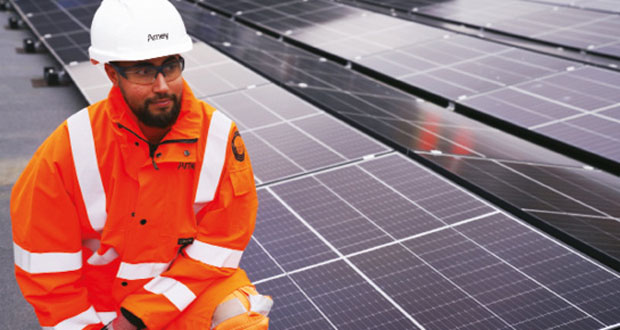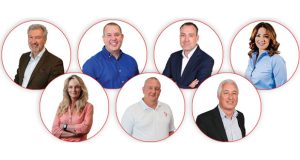David Aird, Director of Strategic Projects at Amey discusses digital innovation within a challenging public landscape
Innovation and technology are at the forefront of the Government’s plans to transform and modernise the public estate. Indeed, in the Digital, Data and Technology Playbook the Government recognised that ‘technology offers an opportunity to transform public services for the better’.
Technology, and the ways in which systems interact, can help drive efficiencies, achieve value for money, reduce carbon and improve the overall workplace experience. However, the quality of data across public buildings is still in its infancy. A review undertaken by the Public Accounts Committee in 2022 said that “failure to replace old technology, and a lack of understanding of the reduction in office use post-pandemic…” is hampering the Government’s ambitions to transform its property portfolio. The drive to replace its ageing database, EPims, to new software that can introduce real-time data for informed decision-making, experienced significant delays in its implementation.
Strategic partners have an opportunity to support the Government’s data journey to optimise their estates and drive strategic decision-making by introducing and integrating their own technology systems. By partnering with specialist supply chain members, strategic partners can use their combined knowledge of the public estate, data analytics and digital expertise to develop platforms that will revolutionise the way that the public sector manages the workplace.
TECHNICAL INTEGRATION
Amey’s newly developed asset management and decarbonisation platform, Technology Hub is a prime example of how this can work in practice. It uses an integrated suite of MRI Software products to create an intuitive user experience which can inform strategic decision-making, reduce whole-life cost and enhance the workplace experience. With MRI’s Evolution advanced CAFM sitting at its heart, the open and connected system integrates multiple asset and energy management platforms. This provides an end-to-end overview of estate performance and enhances the workplace experience for building users through user-friendly customer interfaces.
Technology Hub also allows users to better understand and manage energy consumption and carbon footprint, spend, and building operations. It provides FM teams with the ability to optimise building occupancy, air quality and room temperature, resulting in a healthier and more productive environment for building users.
It acts as a single repository for all client asset information, maintaining a near-live record of performance and compliance, and allowing the delivery of FM, energy services and project management via an integrated suite of complementary products, including MRI eSight Energy Management and OnLocation Occupancy Analytics, to digitalise all aspects of estate management.
PROVIDING OCCUPANCY ANALYTICS
Amey has also started installing this innovative technology across several of its key sites including its London head office. Teams have utilised the OnLocation Occupancy Analytics plugin to create a detailed picture of building occupancy and capacity. If used in isolation, this provides useful data on footfall and desk occupancy. When combined with data on power and utilities usage, indoor air quality and temperature, cleaning and maintenance costs, waste volumes and other data gathered by IoT sensors it can help create a truly smart office environment.
However, when using technology of this nature, it is crucial to bear in mind the pivotal interaction between technology and people by providing transparent communication about the technology’s non-intrusive nature and the advantages it offers to staff.
Technology Hub also includes the ability to use detailed asset data, including information imported from sources such as IoT sensors, drone surveys or the creation of 3D digital twins, to produce long-term replacement plans which optimise clients’ capital budgets. This provides access to building data at the touch of a button. It undertakes audits and builds virtual walk-throughs of properties across an estate which can help to prioritise backlogs in maintenance and advise how an estate is utilised, as well as suggesting solutions to remodel office layouts to improve utilisation.
AI-ENABLED TECHNOLOGY
Another area of innovation is an energy and optimisation AI-enabled technology called Grid Edge. This works by integrating with existing Building Management Systems (BMS) and data systems to contextualise building, energy, occupant, and environmental data. Algorithms continuously scan data to flag anomalies which in turn makes simple adjustments to asset operation to create carbon and cost savings. Grid Edge then provides dynamic, data-driven evidence to identify energy and carbon interventions.
At a trial site for National Highways, Grid Edge can create detailed insights into asset use and the consumption of gas and electricity. If delivered, recommendations could save significant cost saving and carbon reductions.
The introduction of this system posed a complex challenge due to its integration with the BMS requiring close collaboration among key stakeholders, including the BMS supplier, the hosting or on-premise maintainer, and a clear understanding of how the BMS elements are deployed in multi-tenancy buildings.
CONCLUSION
The integration of technology, data and systems is a complex topic. It’s crucial to comprehend the specific IT security arrangements that apply to customers. These arrangements encompass measures to safeguard data integrity, confidentiality, and availability.
There is no doubt that technology is the future of the built environment. By working collaboratively with public sector organisations – infrastructure and decarbonisation service providers alike can revolutionise the way that we manage the public estate. Interpreting data will pave the way for solutions and projects that enable customers to maximise their capital and revenue budgets and drive organisations on the journey to net zero.





